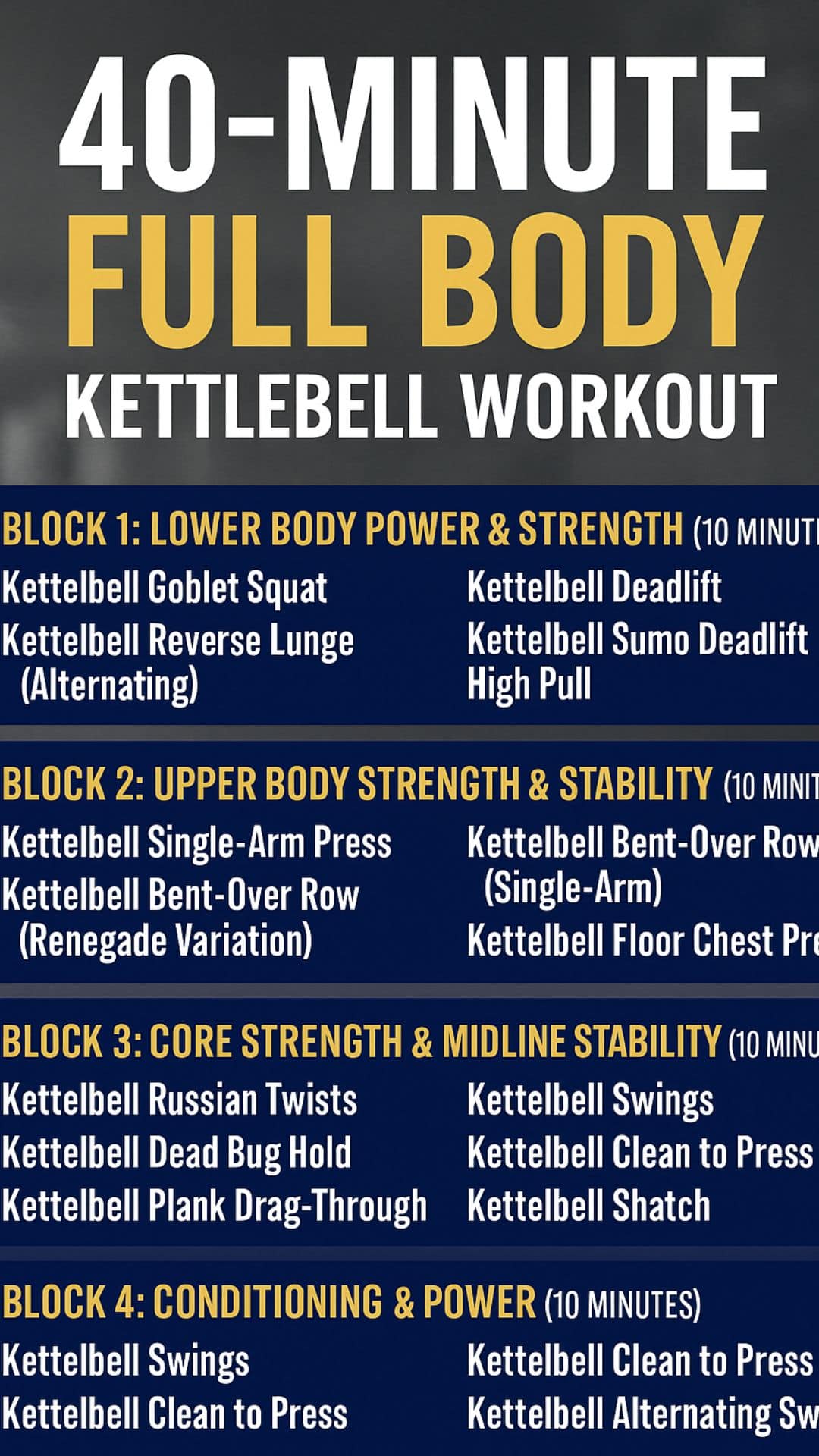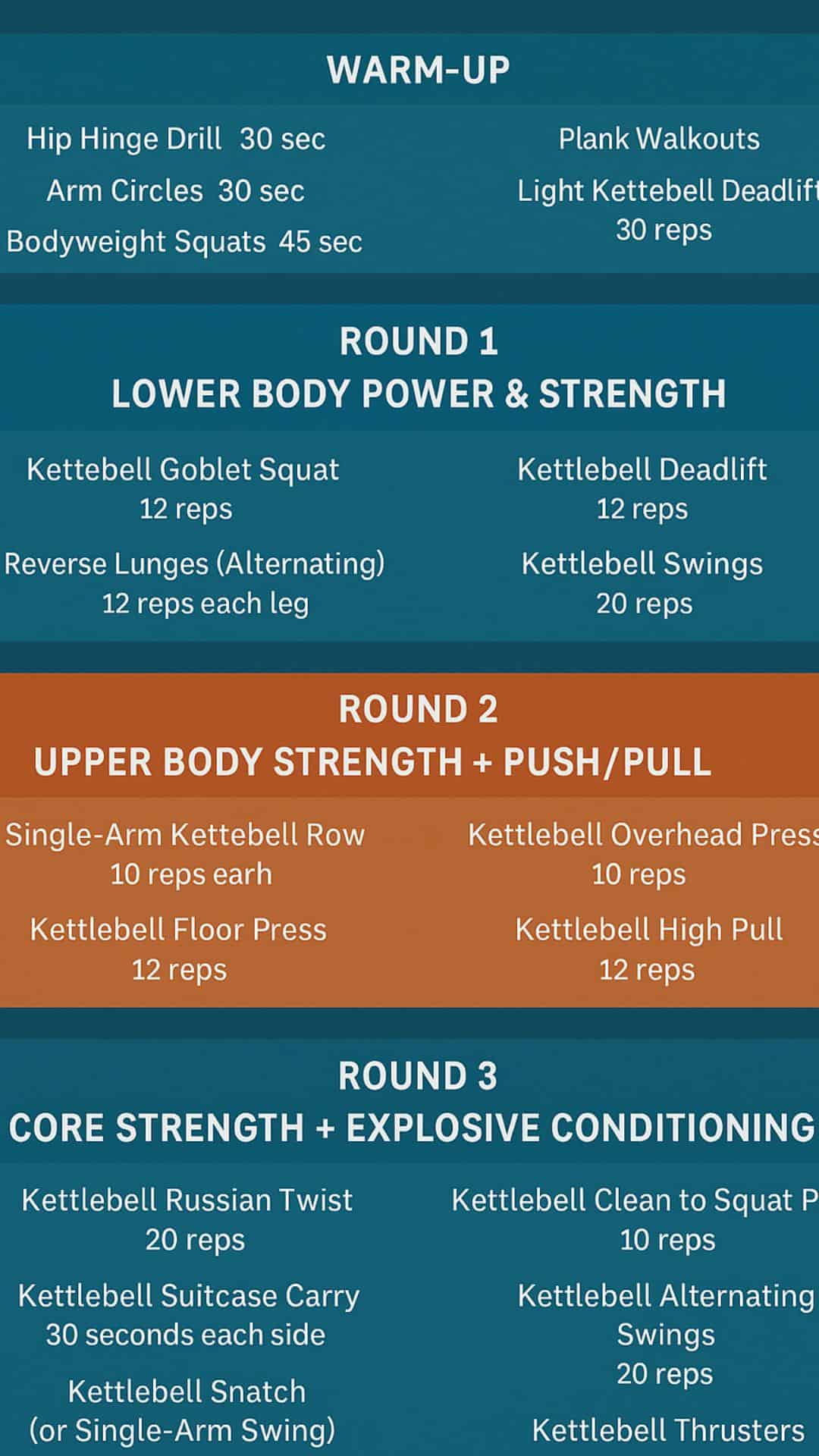
45 Minutes to Fit: A Full-Body Kettlebell Workout for All Levels

40-Minute Full-Body Kettlebell Workout (Build Muscle, Burn Fat)

30-Minute Kettlebell Workout for Total-Body Strength

25-Minute Full Body Kettlebell Workout for Strength & Fat Loss
HIIT Jump Rope Workout A Full Body Fat Burning Routine

Jump rope workouts have been a go-to fitness solution for decades, and for good reason. They combine cardio, strength, agility, and endurance into a simple, yet effective workout. Recently, high-intensity interval training (HIIT) has surged in popularity as one of the most efficient ways to burn fat and improve cardiovascular health. When combined with jump rope exercises, HIIT creates a dynamic, fast-paced workout that can deliver exceptional results. In this blog post, we’ll explore the benefits of a HIIT jump rope workout, how to perform it, and tips to maximize your training.
What is HIIT Jump Rope Workout?
A HIIT jump rope workout merges the principles of high-intensity interval training with the age-old exercise of jump roping. HIIT focuses on short bursts of intense activity followed by brief periods of rest or lower-intensity movement. This method elevates the heart rate quickly, maximizes calorie burn, and pushes the body into a fat-burning zone. Adding a jump rope amplifies the intensity, targeting muscles throughout the body, including the legs, core, and arms.
Why Choose Jump Rope Workout for HIIT?
- Portability: A jump rope is one of the most portable pieces of equipment. You can use it anywhere—whether at home, in a park, or in a gym.
- Low Cost: Jump ropes are inexpensive compared to other fitness gear, making them accessible to anyone looking to improve their fitness.
- Efficient Calorie Burn: Jumping rope can burn up to 15 calories per minute, and when combined with HIIT, this number skyrockets.
- Full-Body Workout: It engages major muscle groups and promotes coordination, agility, and balance, all while offering a killer cardiovascular workout.
Benefits of HIIT Jump Rope Workouts
1. Rapid Fat Loss
HIIT is known for its fat-burning capabilities, and adding a jump rope accelerates this process. The high-intensity intervals push your body into a state of EPOC (excess post-exercise oxygen consumption), meaning your body continues to burn calories even after the workout ends. This “afterburn effect” leads to more fat loss over time.
2. Improved Cardiovascular Health
Both HIIT and jump roping increase heart rate significantly, strengthening your heart and improving circulation. Studies have shown that regular HIIT workouts can lower blood pressure, improve cholesterol levels, and reduce the risk of cardiovascular diseases.
3. Increased Endurance and Stamina
HIIT workouts, particularly with a jump rope, improve your aerobic and anaerobic capacities. This boosts your overall endurance, allowing you to perform longer, more intense workouts over time. The rapid bursts of activity followed by rest periods challenge the lungs and muscles, improving stamina.
4. Full-Body Muscle Toning
While many view jump roping as primarily a leg workout, it actually works the entire body. During the workout, you’ll engage your calves, thighs, and glutes, while the constant swinging motion of the rope tones your arms, shoulders, and core. The fast-paced nature of HIIT also keeps the muscles under tension, promoting strength and muscle toning.
5. Enhanced Coordination and Agility
Jump rope workouts challenge coordination and timing, which is especially beneficial for athletes or anyone looking to improve agility. As you progress in your HIIT jump rope routines, you’ll notice improved hand-eye coordination, reflexes, and balance.
HIIT Jump Rope Workout Plan
To maximize the benefits of this workout, follow a structured HIIT jump rope routine that balances intensity with recovery. The plan below is a beginner-friendly routine that can be scaled up as you become more proficient.
Warm-Up (5 Minutes)
A proper warm-up is crucial to prevent injury and prepare your muscles for high-intensity work. Start with light dynamic movements to increase blood flow and improve flexibility.
- Arm Circles: 30 seconds
- Leg Swings: 30 seconds on each leg
- Jumping Jacks: 1 minute
- High Knees (without rope): 1 minute
- Butt Kicks (without rope): 1 minute
HIIT Jump Rope Circuit Workout (20-30 Minutes)
This circuit involves 30 seconds of high-intensity jump rope followed by 30 seconds of active rest or low-intensity exercise. Repeat the circuit 4-6 times depending on your fitness level.
1. Basic Jump (2 Rounds)
- How to Perform: Jump with both feet together, keeping your jumps low and controlled. Engage your core to stabilize your body.
- Focus: This is your base movement, designed to elevate your heart rate.
2. Single-Leg Jump (2 Rounds)
- How to Perform: Jump on one foot for 15 seconds, then switch to the other foot for another 15 seconds.
- Focus: This movement improves balance, coordination, and single-leg strength.
3. High Knees Jump (2 Rounds)
- How to Perform: Jump with a rapid pace, bringing your knees as high as possible toward your chest on each jump.
- Focus: Engage your core and maintain quick feet to burn calories faster and improve agility.
4. Criss-Cross Jump (2 Rounds)
- How to Perform: Cross your arms in front of you and jump through the loop, then uncross on the next jump. Repeat in a rhythm.
- Focus: This advanced move targets your upper body, specifically the shoulders and arms, while improving coordination.
5. Double Unders (1-2 Rounds)
- How to Perform: Swing the rope twice under your feet in one jump. This move requires explosive power and timing.
- Focus: Double unders are an advanced move that targets speed, power, and endurance.
Active Rest Intervals
Between each round of jumping, engage in these low-intensity exercises for 30 seconds. They will keep your heart rate elevated while allowing your muscles to recover:
- Bodyweight Squats
- Plank
- Lunges
- Mountain Climbers
Cool Down (5 Minutes)
Cooling down is just as important as warming up. Stretch out the muscles you worked and bring your heart rate down gradually.
- Standing Hamstring Stretch: 30 seconds per leg
- Quadriceps Stretch: 30 seconds per leg
- Shoulder Stretch: 30 seconds per arm
- Chest Stretch: 30 seconds
- Child’s Pose: 1 minute
How to Progress Your HIIT Jump Rope Workout
Once you’re comfortable with the basic workout, you can start to scale it for more intensity. Here’s how:
1. Increase Time or Reps
As your fitness improves, extend your work intervals to 40 or 45 seconds while keeping your rest intervals at 30 seconds. Alternatively, increase the number of rounds you perform for each jump rope variation.
2. Add More Advanced Moves
Incorporate more advanced techniques like double unders, crossovers, or triple unders as you gain more control and strength.
3. Include Weights
For an added challenge, you can include weighted jump ropes or wear a weighted vest during your workout. This will engage your muscles more and improve strength and endurance.
4. Incorporate More Bodyweight Movements
Between jump rope intervals, add bodyweight exercises like push-ups, burpees, or jumping lunges. This will elevate your heart rate even further and target different muscle groups.
Common Mistakes to Avoid With HIIT Jump Rope Workout
1. Skipping the Warm-Up and Cool-Down
Jumping straight into a HIIT jump rope workout without warming up can lead to injuries. Always spend at least 5 minutes warming up before you start, and make time to stretch afterward to aid muscle recovery.
2. Using the Wrong Jump Rope
Choosing the wrong rope size can hinder your performance. Make sure your jump rope is properly sized. When you step on the middle of the rope, the handles should reach your armpits. A too-long or too-short rope can cause unnecessary mistakes and frustration.
3. Poor Form
Maintaining proper form is crucial for preventing injuries and getting the most out of your workout. Keep your jumps low, land softly on the balls of your feet, and engage your core throughout the workout. Avoid swinging your arms excessively; the movement should primarily come from the wrists.
4. Not Pushing Yourself During Intervals
HIIT is all about intensity, so don’t hold back during the high-intensity intervals. Give it your all during the 30 seconds of jump rope, and then use the rest period to recover.
The HIIT jump rope workout is an exceptional way to burn fat, build endurance, and tone your entire body in a short amount of time. With its portability and versatility, this workout can fit into any lifestyle, whether you’re working out at home, at the gym, or even traveling. The key to success lies in consistency, progression, and maintaining proper form.
Most Recommended
Subscribe to our Newsletter
Stay up to date on the latest men’s health, fitness and lifestyle trends and tips.
About Us
Men’s Fit Club was started with the goal of empowering men to get the most out of their lives. This meant going beyond exercise and diet tips to really address the broad range of issues that men face on a daily basis – topics like recreation, finding love, sexual health and even sound fashion advice.
Quick Links
© COPYRIGHT MEN'S FIT CLUB 2026. All Rights Reserved

